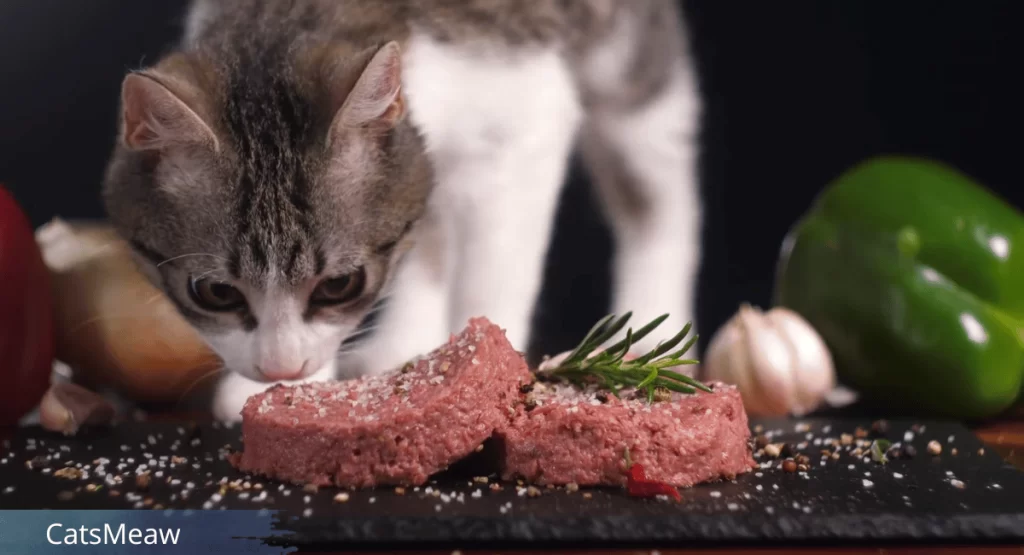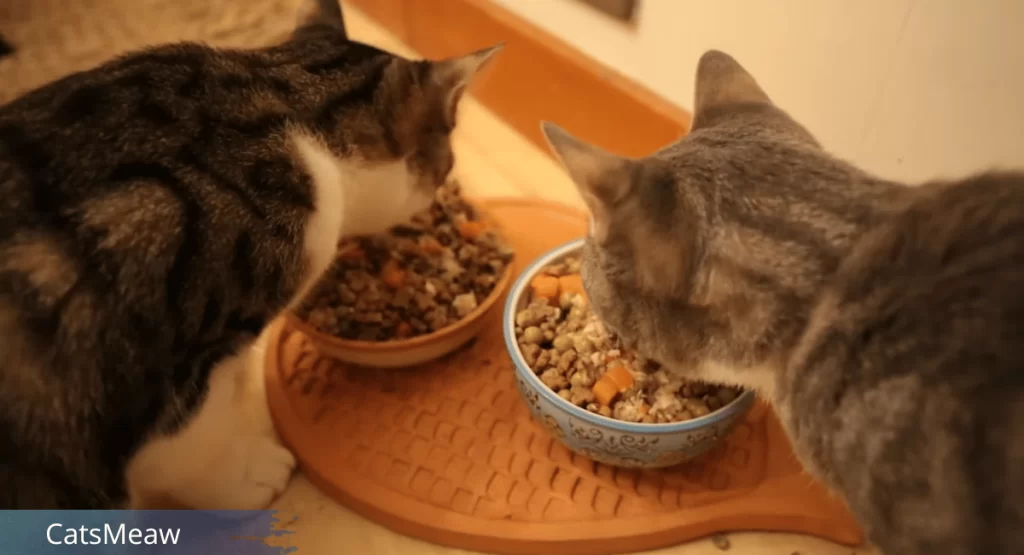When it comes to our feline companions, their health and happiness are of utmost importance to us. One of the fundamental aspects of ensuring a healthy life for our cats revolves around their diet. how much to feed a cat?
This question, simple as it might seem, entails a myriad of considerations, from the specific nutritional needs of our cat to the common pitfalls many pet owners encounter. In this comprehensive guide, we will delve into the feeding guidelines that will help you understand the optimal way to feed your cat, ensuring they get the right amount of nutrients without overfeeding or underfeeding.

Table of Contents
Importance of Feeding Guidelines for Cats
Feeding your cat might seem as straightforward as pouring some kibble into a bowl, but the truth goes much deeper. The importance of adhering to proper feeding guidelines cannot be overstated. Firstly, it helps maintain an ideal weight for your cat, preventing obesity or undernutrition, both of which can lead to serious health issues.
Secondly, understanding and following these guidelines ensure that your cat receives the right balance of nutrients necessary for their energy levels, immune system, skin, and coat health. Lastly, it aids in preventing diet-related diseases such as diabetes or urinary tract problems, which are prevalent in cats due to improper nutrition.
Adhering to feeding guidelines isn’t just about the quantity of food but also about the quality and composition of their diet. It’s a balancing act that requires insight into what makes up a nutritious meal for a cat at various stages of their life. As pet owners, we have the responsibility to ensure that our feeding practices promote longevity and quality of life for our furry companions.
Factors to Consider When Determining How Much to Feed a Cat
Determining the right amount of food involves considering several key factors. Firstly, the age of your cat plays a crucial role; kittens have different nutritional needs compared to adult or senior cats. Their energy levels and metabolism rate also influence how much to feed a cat. For instance, a highly active cat will naturally need more calories than a sedentary one.
Another significant factor is the cat’s weight and body condition. A cat that’s overweight might need a reduced-calorie diet to reach a healthier weight, while an underweight cat requires more calories to gain weight. Moreover, any specific health issues or dietary needs must be taken into account, as they can drastically alter the amount and type of food your cat should be consuming.
Our pick: The Best Cat Food for Indoor Cats
Lastly, the type of food you’re feeding your cat – whether it’s dry kibble, wet food, or a combination of both – will influence the portion sizes. Wet food, for instance, contains more water and is less calorie-dense than dry food, meaning you might need to adjust the amount accordingly.
Understanding Your Cat’s Nutritional Needs
Cats are obligate carnivores, that means their diet should primarily consist of meat. This biological necessity stems from their need for specific nutrients that are only found in animal products, such as taurine, arachidonic acid, and vitamin A. These nutrients are vital for various bodily functions, including vision, heart health, and reproduction.
A balanced diet for a cat also includes the right proportions of proteins, fats, carbohydrates, vitamins, and minerals. Protein is particularly important for muscle maintenance and overall growth, while fats provide energy and help absorb certain vitamins. Carbohydrates, though less essential, serve as an additional energy source. However, it’s crucial to ensure that the diet is not overloaded with carbohydrates, as this can lead to obesity.
Understanding these nutritional needs is the first step towards choosing the right food for your cat and determining the correct portion sizes. Always look for high-quality cat food that meets the nutritional standards set by the Association of American Feed Control Officials (AAFCO), ensuring that the food provides complete and balanced nutrition.
Common Feeding Mistakes to Avoid
One of the most common feeding mistakes is overfeeding, which often leads to obesity. Many cat’s owners misinterpret their cat’s signals, offering food whenever their cat meows or seems interested in food, which can contribute to weight gain. Another mistake is offering too much variety in the diet, which can cause pickiness or digestive issues. Cats thrive on routine and consistency in their diet.
Related: 7 Most Dangerous foods for cats
Additionally, relying solely on dry food can be problematic for some cats, especially those prone to urinary tract diseases, as it has lower moisture content compared to wet food. It’s also essential to avoid giving your cat dog food or human food, as these do not meet the nutritional requirements of cats and can even be harmful.
Lastly, not providing enough fresh water daily is a mistake that can lead to dehydration, especially if your cat’s diet primarily consists of dry food. Always ensure that your cat has access to clean, fresh water at all times.
Determining the Appropriate Portion Size for Your Cat
The appropriate portion size for your cat depends on various factors, including age, weight, activity level, and the type of food you’re feeding. A general guideline is to start with the feeding recommendations provided on the cat food packaging, which are usually based on weight. However, these are just starting points and might need adjustments.

For an average adult cat, the typical daily intake is about 20 calories per pound of body weight, but this can vary. Monitoring your cat’s weight and body condition closely will help you adjust the portion sizes as needed. If you notice your cat is gaining or losing weight on their current diet, it’s time to reassess the amount of food you’re providing.
It’s also worth consulting with a veterinarian, who can help you determine the ideal portion size for your cat based on their specific needs and circumstances. They can also provide valuable advice on how to adjust portion sizes for weight management effectively.
Types of Cat Food and Their Feeding Recommendations
There are three main types of cat food: dry, wet, and raw. Each type has its feeding recommendations and benefits. Dry food, or kibble, is convenient and tends to be less expensive than wet food. It can be left out for free-feeding without spoiling quickly. However, it’s important to ensure your cat drinks enough water if their diet is primarily dry food.
Wet food is higher in moisture and can be beneficial for cats with urinary tract issues or those who struggle to stay hydrated. It’s usually more palatable and closer to a cat’s natural diet in texture, but it can spoil if left out too long. Raw diets aim to mimic a cat’s natural diet in the wild and can offer high-quality nutrition, but they require careful handling to prevent bacterial contamination.
When feeding your cat, whether it’s dry, wet, or raw food, always follow the manufacturer’s recommendations and adjust based on your cat’s specific needs. Also, consider combining different types of food to provide variety and balance in their diet.
Creating a Feeding Schedule for Your Cat
Creating a consistent feeding schedule helps regulate your cat’s digestion and ensures they’re receiving the right amount of food at the right times. For most cats, feeding twice a day – once in the morning and once in the evening – works well. This mimics their natural hunting behavior, providing a routine that can reduce anxiety and prevent overeating.
For kittens or senior cats, more frequent feedings might be necessary due to their higher nutritional needs and smaller stomach capacities. Kittens, for example, may require feeding three to four times a day. Always consult with your veterinarian to determine the best feeding schedule for your cat’s specific needs.
Remember, the key to a successful feeding schedule is consistency. Feeding your cat at the same times each day helps them feel secure and maintains their metabolic rate, aiding in better digestion and overall health.
Special Considerations for Feeding Kittens and Senior Cats
Kittens and senior cats have unique nutritional needs that require special consideration. Kittens, growing rapidly, need a diet rich in proteins and calories to support their development. They also benefit from more frequent feedings to accommodate their smaller stomachs and higher energy requirements.
On the other hand, senior cats, who may be less active, require fewer calories to prevent obesity. However, they still need a diet high in quality protein to maintain muscle mass and may need supplements to support joint health and cognitive function.
For both kittens and senior cats, it’s crucial to choose food that’s specifically formulated for their life stage, providing the right balance of nutrients to support their health and well-being. Your veterinarian can offer guidance on the best diet and feeding practices for your kitten or senior cat, ensuring they receive the care and nutrition they need at every stage of life.
Conclusion
Feeding your cat is not just about satisfying their hunger; it’s about providing them with the nutrition they need to live a long, healthy life. By understanding the importance of feeding guidelines, considering the factors that influence how much to feed a cat, and avoiding common feeding mistakes, you can ensure that your cat maintains an ideal weight and receives the right balance of nutrients. Remember, each cat is unique, and their feeding requirements will change over time.
Related: Feeding Your Cat: Essential Tips for a Healthy Feline
Regular consultations with your veterinarian, along with careful observation and adjustment of feeding practices, will help you cater to your cat’s specific needs at every stage of their life.
Feeding your cat the right amount and type of food is a critical component of responsible pet ownership. With the guidelines and insights provided in this article, you’re well-equipped to make informed decisions about your cat’s diet, ensuring their health and happiness for years to come.

